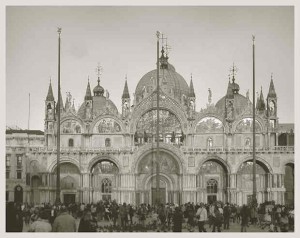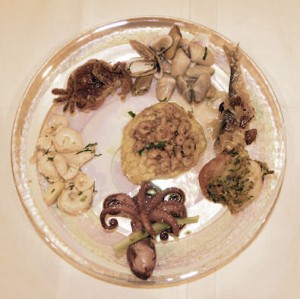
We selected wines which are the greatest ambassadors to the Veneto and Friuli Venezia Giulia — the closest wine regions to Venice — Prosecco, Amarone, Soave, Picolit to name but a few. We concentrated on wines made from the local autocthonous grape varieties paired to local food dishes prepared using only the best and freshest local ingredients. This private dinner took place in a beautiful Venetian palazzo, with the finest plates and glassware from the island of Murano.
The object of this event was to explore the regions near Venice through its wines, giving preference to those wines which one could characterise as having great finesse and elegance - the opposite of over-oaked and extracted wines. Why Ambassadors to Venice? Because all the neighbouring regions to Venice send their wines into the city for the benefit of the tourists and are, indeed, ambassadors of the regions they represent. In 2007, it was predicted that 20 million tourists would visit this city where they would eat and drink the local food and wines and, of course, consume a lot of pizza in its various forms
The main wine growing regions of this northern part of Italy are the Veneto with its wines of Valpolicella and Soave, Conegliano-Valdobbiadene from which Prosecco comes and Friuli Venezia Giulia whose main wine producing area is the Collio. There is also the rather small inhospitable region of the Carso, a small zone above the city of Trieste. What is interesting for wine lovers is that each of these areas produces excellent wines which are intrinsically different from each other. All of the areas produce wines from autocthonous grape varieties (grapes which originated from these zones) and which seldom find expression elsewhere. So, for example, Prosecco - the name of an indigenous varietal - which make a clean and fruity sparkling wine (spumante) widely consumed in Venice and now in the UK. Amarone, produced in Valpolicella, using, amongst others the Corvina grape. The newly renamed Friulano (formerly known as Tocai) which is a unique variety to this region and in the Carso, the varietal known as Vitovska.
The wines needed to be paired with local Venetian food which would compliment and enhance their organoleptic qualities, aromas, bouquet and particularly important, and largely ignored, their textures. The wines were grouped with different courses (see menu) on the basis that they are specific examples or have similarities either by varietal or production (eg use of wood barrels in their aging). Obviously, the dinner was the product of extensive researches, and the food and wine matches had been tested prior to the main event.
It made sense to start with the hugely popular aperitif wine - Prosecco. The most reknown area for Prosecco is the DOC Prosecco di Conegliano-Valdobbiadene. The driest form - brut – is particularly good as an aperitif. Unlike many other types of wine, Prosecco is the name of a grape variety and not a region. Prosecco 'Brut' indicates that the residual sugar levels are relatively low which gives the wines a refreshing taste, which is both clean and fruity. To emphasise this the chef had prepared some short crust canapés which had a brittle texture complimenting the mousse - sparkling wines work well with friable foods. As an added feature some were coated in a small quantity of honey which reflected the present levels of sugar even if the perception was that the wines were dry. However, Prosecco works well even on its own and it has been said that the best thing for accompanying a glass of Prosecco is... another glass of Prosecco.

The next pair of wines were quite different but essentially they shared one characteristic which was a fairly intense flavour coupled with a buttery texture and backed with good acidity. These kinds of wines go excellently with fish. The chef had rather gone to town in producing a platter of wonderful local delicacies (see photo and caption). These were an excellent match whilst people preferred the wine from the Collio over that of the Carso it was perhaps more to do with the way the wines are vinified. Toros manages to obtain terrific finesse in his Friulano whilst keeping the alcohol under control. There are examples of this wine with more than 16° of alcohol - that doesn't make for a drinkable wine.
The true spirit of a great spumante is alive and well in Slovenia - Movia. Puro rosé, 2001. Primorska, Brda (Slovenia). The history of this whole region is one of sequential rule from one empire to the next. At some period in history Movia was in a part of the country which was once part of the Venetian Empire (qualifying for this supper). Puro is a spumante made with Pinot Nero 60%, Chardonnay 10%, and the auctocthonous variety Ribolla Gialla 30%. The character of the wine is one of great freshness and very clean but also long and dry (they add no additional sugar). The fact of leaving the wine undisgorged means that the wine will age well without the usual oxidative qualities of, say, a vintage Champagne. This wine demanded something special. Foie gras is often thought of as being terrific with sweet wines, which it is. Here, it worked beautifully too, and despite the addition of Calvados to the foie gras, the wine coped and the sweetness of the Pinot Noir and the texture of the small toasts with the spumante worked beautifully. This was a very popular match from all points of view.
The area of Soave produces some 60 million bottle per annum. One of the main characteristics of the area and the Classico area in particular is the volcanic activity which gave the dark soils in the hills made of lava and basalt. Another main characteristic is the method of training the vines - the Pergola Veronese (also used in nearby Valpolicella) which make the vineyards so distinctive. The zone of Soave divides between the DOC of the plains and the hills of Soave Classico. The main varietal here is the Garganega which gives a wine elegance and finesse. An important development in the region is the appearance of the Cru in Soave where an increasing number of conscientious wineries are looking to maximise the qualities of specific vineyards. Something subtle and refined was called for to play these wines and draw out the characteristics of the terroir. A common dish in all of Italy is risotto but it is also the most adaptable and refined. The rise absorbs the subtle flavours of the stock and pumpkin. The tough thing was to follow the foie gras.
The big event of the evening was of course, the reds. Valpolicella and Amarone di Valpolicella. Amarone is the ‘dry’ version of recioto which achieves mainly between 15° -16° of alcohol, with a high extract, a generous and velvet style body with a distinct bouquet from its prolonged aging. The autocthonous vines from which all Valpolicella DOC wines are made were regulated as of 1968 and include the following: Corvina Veronese, Corvinone, Rondinella and other which should not make up more than 15% of the total in a wine: Molinara, Dindarella (Pelara, Quaiara), Oseleta, Rossignola, Negrara (Negrara trentina, Terodola) and Forsellina.
Allegrini was the winemaker selected to represent this region, and for good reason. He makes some of the finest and most elegant wines of the area which are much prized around the world. Their low levels of sugar are particularly helpful in pairing with food. These are big, smooth wines which were paired with a goose breast, a side of braised pear in Amarone to draw out their best qualities, the pear playing with the residual sweetness of the wine, and potato purée. This was definitely the high spot of the evening for most even if it had been quite a long journey to get there. Each of the wines was simply exemplary and the older Amarone (from 1997) pulled one into its depth and magnitude. An emotional moment. ‘Amarone’ in Italian means the ‘bitter one’ and comes from the fermentation of the sugars into alcohol from which the sweet derives. In reality, the wine is dry rather than ‘bitter’. The wine is characterised by a relatively high alcohol level which is never less than 14
Whilst appetites were fairly sated, and despite the number of wines, there were no signs of any overindulgence. Dried biscuits provided the requisite mouthful of brittleness and crunch to pair with the last wine of the evening. Something sweet was called for., which was niether too fat nor syrupy. An added advantage would be a wine which was also refreshing and soothing. Picolit is a wine which is made from a proportion of grapes (the autocthonous variety Picolit) which have undergone appassimento - drying and concentrating. It is also unique in the wine world since the vine suffers from a defect known as floral abortion which is a major feature of the quality of the wine because it keeps yields down to a minimum. The harvest is always late - for example, they harvested their last grapes in 2008 at the end of October.
A dinner of this kind, which took months of planning, was augmented by the use of beautiful plates and glasses from the nearby island of Murano. It made no sense to host a dinner like this in the heart of Venice, in an historic house, without using Venice's great exports, its own ambasadors, their glass. To eat off beautiful plates and taste wines in beautifully crafted and and designed glassware which pull all the flavours from the wine is an essential component of such an enterprise and the evening would have been the poorer for lacking these details.
As some of the guests slid off into the misty still night of this beautiful city one was reminded of poet Joseph Brodsky's answer to the question, what is Venice like in winter? 'Like Greta Garbo swimming', he replied. An abstruse and esoteric reference which one can ponder for a long time, not totally unlike the dinner.










